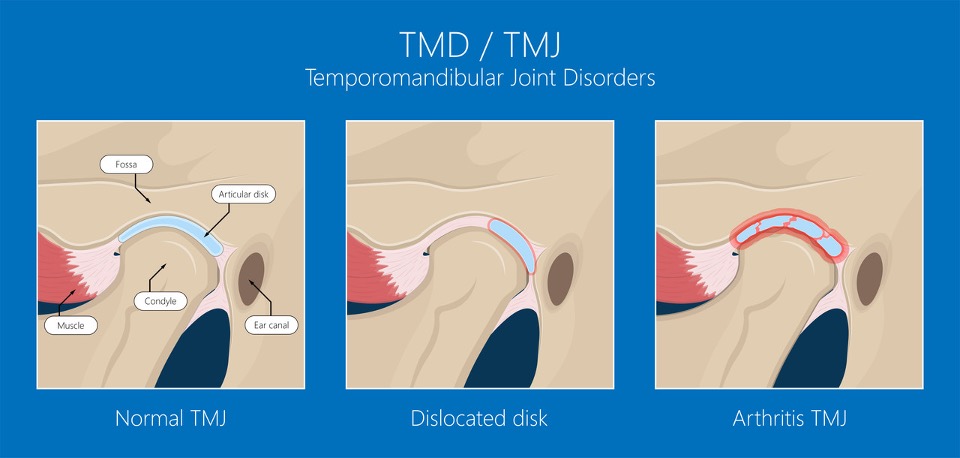What is a TMD (TMJ jaw dysfunction)?
Sep 16, 2023 23:05
TMD stands for Temporomandibular Disorder, classified by chronic migraines, dull pain around the ears, neck spasms, and nighttime sleep disturbances with sleep apnea. Some people live with these symptoms for years. They seek help from various general practitioners, take medications, and undergo courses of therapeutic massages. However, these approaches only provide temporary relief.
Few people turn to a neuromuscular dentist when experiencing these symptoms. Yet, often the underlying cause is dysfunction in the temporomandibular joint.
TMD jaw disorder
The temporomandibular joints are located in the area around the ears on both sides of the skull. They connect the lower jaw to the immobile temporal bone of the upper jaw. These joints consist of an articular head and a temporal cavity. A joint disc, situated between them, is responsible for reducing friction during chewing and speaking.

When functioning properly, the joints move synchronously, and the teeth come together evenly when the jaws are closed. The facial chewing muscles are in a comfortable state.
Pathological changes in the shape of the temporomandibular joints or disruptions in their synchronized movements, along with improper functioning of the facial muscles, are referred to as temporomandibular joint dysfunction (TMD). This condition disrupts the harmonious interplay between the chewing muscles, tendons, and dental arches.
Without proper treatment over an extended period, TMD-related issues can lead to facial asymmetry, posture disturbances, and misalignment of several organs. Additionally, serious health problems may arise as a consequence.
Symptoms
The following conditions are characteristic of temporomandibular joint dysfunction (“TMJ” refers to the temporomandibular joint itself):
• Frequent headaches and dizziness.
• Sensation of tightness in facial muscles or jaw stiffness in the mornings.
• Nighttime snoring.
• Clicking or popping of the jaw.
• Noises and pain in the ears.
• Increased teeth grinding.
• Rapid fatigue of facial muscles while chewing food.
• Depression due to constant pain/discomfort.
How is TMD Diagnosed?
For the successful treatment of temporomandibular joint dysfunction (TMJ), it is essential to diagnose the root cause of the problem. A comprehensive examination of the patient at the neuromuscular level is required.
CMS (Lower Jaw Motion Scan)
A 3D analysis of the trajectory of the lower jaw movement is performed. The doctor pays attention to the extent of the joint heads' displacement from the temporomandibular joint during the patient's mouth opening and closing. They also assess how much the position of the lower jaw deviates from the norm during closure. The doctor determines its ideal position where facial muscles are not strained.
EMG (Electromyography)
Using special sensors placed on the face, the doctor studies the activity of facial muscles. Deviations from the norm are detected with high precision, up to 10 microns.
ESG (Electrosonography)
Sensors capture extraneous noises (clicking, popping) during jaw closure and opening at high and low frequencies.
CT (Computed Tomography)
Bone structures are examined, including the spinal column, individual cervical vertebrae, nasal septum, airway passage, and the temporomandibular joint with its heads. The condition of the teeth is also evaluated.
When should I see a doctor regarding my symptoms of TMJ?
Have you noticed symptoms of temporomandibular joint dysfunction (TMJ)? Do not delay visiting a neuromuscular dentist. If you refrain from seeking treatment before critical wear of the temporomandibular joint disc, it cannot be restored.
Treatment
After treatment of TMD:
• Migraines and dizziness will disappear. You'll forget about constant headaches. The noise in your ears will vanish, and the feeling of pressure in your temples will go away. The numbness in the back of the head will stop.
• Your face will rejuvenate. Signs of facial aging will disappear, including nasolabial wrinkles. Your skin will become tighter.
• Your posture will improve. Proper blood circulation in the head and neck will be restored. Your sleep will normalize. Your physical condition will improve, and your performance will increase."







































































